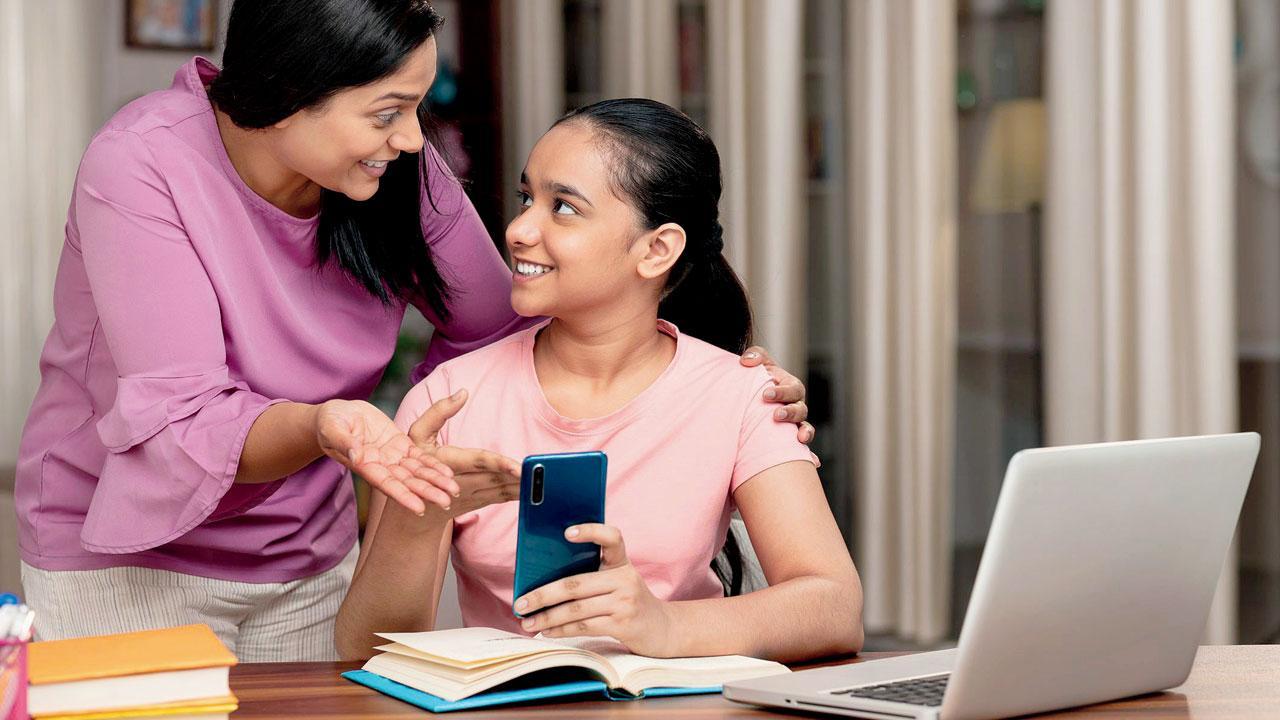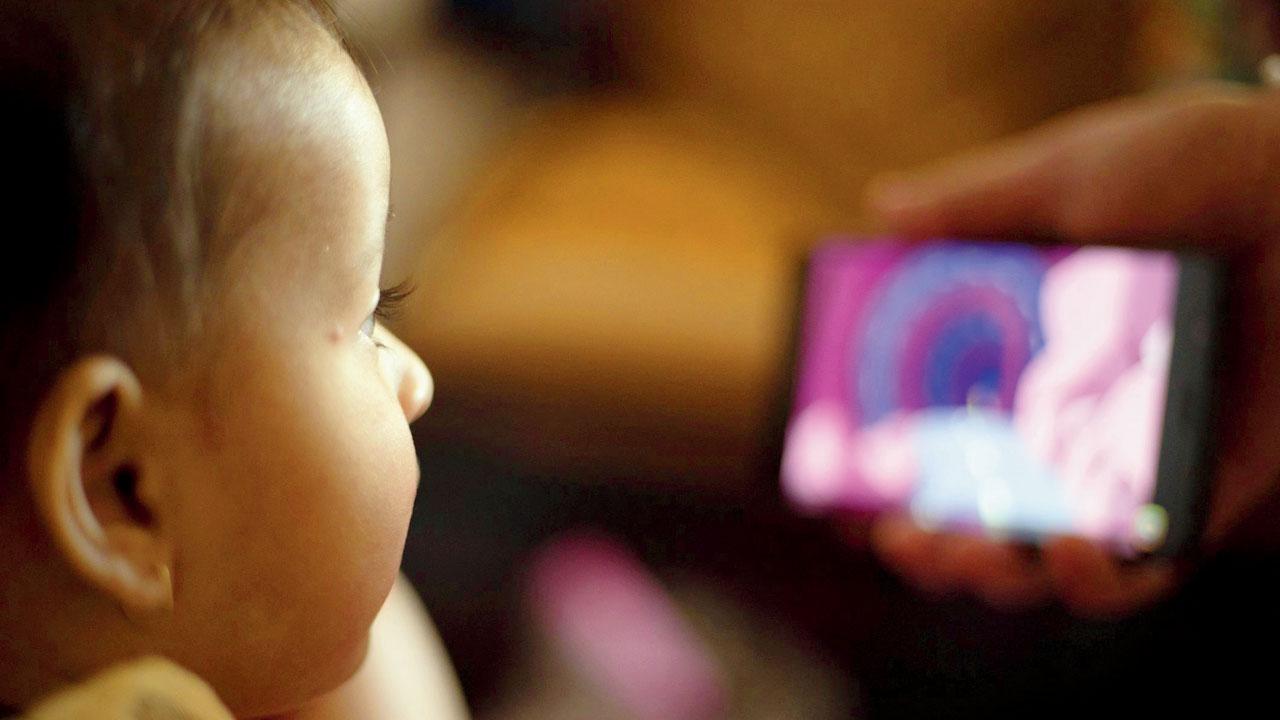Experts share how to approach screen time consumption for kids after Apple CEO Tim Cook recently made a statement about the need to set boundaries for technology access for them

Be involved with your child’s phone usage by asking questions about the games they play and teaching them how to use the phone in a healthy manner so as to prevent long-term effects. Representation Pic
In a recent interview with Apple CEO Tim Cook (above), the interviewer shared that his child was obsessed with his smartphone. Cook continued that today’s children are born in a digital era, terming them “digital kids”, and that it is important to set boundaries when it comes to their technology usage. But how do parents and school administrators inculcate a healthy relationship with smartphones in today’s tech-savvy children? Experts decode it for us.

Setting boundaries
Parenting expert Tejashri Acharya explains that parents should delay introducing their children to screens and gadgets, or avoid it completely till the age of two. Post this, they should not exceed one hour of screen time for toddlers. Knowing that tantrums will be common, Acharya warns against negative associations with screens such as angrily taking the phone away. Give it happily, take it happily, she notes and adds, “When tantrums occur while taking away a gadget, calmly empathise with your child, take the gadget back. Remember to connect before you correct.”
Another method is to enjoy phone time together. Acharya points out that you might not want to take the phone or laptop away while the child is enjoying a game. Instead be involved, understand the game, how your child plays it, and ask them questions. This can give you a chance to have meaningful conversations about phone usage with them, which may eventually help them approach gadgets in a healthier way.
It’s all about the content

Chetan D’Souza
Acharya also notes the importance of kid-friendly content while emphasising quality screen time over quantity. Chetan D’Souza, a parent and founder of KidzByte, a mobile application that curates news for children, adds, “Post the pandemic, screen time among children of all age groups has increased, thus creating a profound impact on their social, emotional, cognitive and physical development. Learning how to use media and technology wisely is an essential skill that we must inculcate in them.” For this, he suggests rethinking screen time where content is more important than the time kids spend on devices.
Is screen time necessary?

Prachi Srivastava
However, Prachi Srivastava, child and adolescent psychologist, disagrees. She notes that giving a child a gadget is nothing more than a convenient thing. “The more we label children as digital children, the more we will succumb to giving them a phone,” she notes and continues that exposure to technology is not necessary. She points out that adults should interact with and encourage children to use and build on their imagination instead of feeding them digital content and tools. “A child can’t entertain themselves. So instead of giving them a gadget, be involved [with their growth and mental stimulation] and offer the tools, environment and space to feed other interests and hobbies,” Srivastava suggests.
How to use digital tools
D’Souza highlights that knowledge about data protection and privacy are important concepts for parents and children to understand in these times. He continues, “By introducing learning modules that cover healthy screen time, cyberbullying, online privacy protection and other relevant topics, we’ll be able to guide children on their quest for knowledge and help them become a responsible digital generation.” He adds, “Every child has a voice of their own, and so it’s good to have them participate in the content creation environment and experience. The journey from content consumers to creators can positively impact peer-to-peer learning.”

Delay the introduction of screens for babies and toddlers. Engage the children using offline tools that feed their imagination, hobbies and interests
Thoughts on e-learning
Srivastava [keeping urban India in mind] counters this and notes that books and field visits trump online research for young minds, since the latter turns learning non-experiential. Feeding information from outside or from researching information online makes us co-dependent on technology, limiting the possibility of relying on our questioning and interpretation skills and imagination.
Uma Kogekar, CEO of CEQUE, a not-for-profit organisation that works with teachers of government and low-income private schools to establish better pedagogic practices, believes that using digital tools and e-learning is neither good nor bad. Instead, how we use these tools to create meaningful learning experiences for students matters.

Uma Kogekar
“If the usage is focused towards consumption of content, however well-made or engaging it may be, the role of the learner tends to be more passive. The role of a teacher here is critical in crafting learning experiences that foster critical thinking skills.” She explains that the nature of learning as a social endeavour was recognised during the pandemic when schooling moved online and digital tools only supported the work in a classroom. She adds, “In an age of personalised learning through digital tools, teachers will still play the central role in fostering a love for learning, skills of collaboration and building academic tenacity.”
Kogekar continues that the issues are different for students in rural India who are on the other side of the digital divide. “Access to digital devices, availability of network and other economic disadvantages are the reality. An investment in the above along with skilling teachers in rural India would be a first step towards putting underserved students at par with their peers in urban India, helping them reap the benefits of a well-designed curriculum aided by digital tools that are contextual and language-specific,” she concludes.
Avoid the trap

1. Give your child their personal phones as late as possible
2. Have clarity on screen time limits and communicate it with your child. Involve your child in setting these boundaries.
3. Show your child how to use technology in a healthy manner for studies and hobbies.
4. Ensure you connect with your child without screens.
Tejashri Acharya
 Subscribe today by clicking the link and stay updated with the latest news!" Click here!
Subscribe today by clicking the link and stay updated with the latest news!" Click here!










